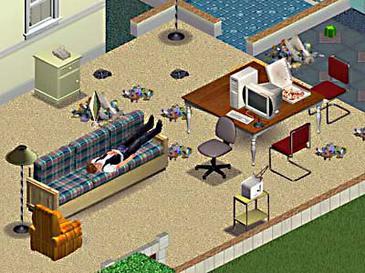Ryan Trecartin’s works are produced within a wide circle of co-producers, primarily the sculptor Lizzie Fitch, yet Trecartin keenly rejects any suggestion that the group of artists and performers involved are a collective, stating ‘The way Lizzie Fitch and I work with collaborators has grown out of a network culture perspective that sees authorship as a fluid space and collaboration as an inherent, connective reality.’[1] This ‘network culture’ approach can perhaps be best engendered as a nesting of practices, extending into the scripting process, in which the ‘sets, props, costumes, hair and makeup…constitute a type of script.’[2] In the final edit the whole created world becomes simply ‘raw supplies’,[3] with all possibilities of narrative, timeline and character achieving horizontal parity.
Where real-world settings are used, such as the semi-derelict L.A. masonic temple used for Temple Time (2016) the setting becomes directly implicated in the work, with Trecartin stating that ‘we were thinking of the building as the protagonist and the building itself was the main character of this piece.’[4] There are clear echoes here of Artaud’s orientation towards materiality as instigator and not simply backdrop to the dramatic, as his manifesto states: ‘Staging: This archetypal theatre language will be formed around staging not simply viewed as one degree of refraction of the script on stage, but as the starting point for theatrical creation.’[5] The closed-world constructed set shared by three of the Priority Innfield movies has an overbearing impetus upon the work; its low-ceilinged, wide rooms have an ominously awkward architecture, evoking reality TV studios, furniture showrooms or theme park facades.
The three movies filmed within this set go nowhere, both spatially and in terms of narrative, the zones, edges and boundaries of the set constituting their whole world. The interior is populated by the kind of disjointed amalgam of furniture and objects that might occur only within video games such as The Sims (Will Wright – 2000) a mixture reflecting the transient tastes, attention spans and spending habits of anhedonic millenial youth. Everything is incoherently positioned, and incompletely constructed, making it very hard to get a clear sense of the space’s organisation through the movies, which dart between locations, usually in constantly moving hand-held shots that defy the viewer a clear look at the background.


The default material state in Priority Innfield is one of infinite admixture – there are recurrent moments of characters smashing cinder blocks with their bare hands and squeezing the red plastic cups synonymous with ‘frat parties’ until they shatter, ultimately becoming a texture of fragmented matter. Other objects appear stranded, such as the yacht that features prominently in Comma Boat pulled up on dry land. In Trecartin’s universe, to be a prop is to be solid, stable, linear, distinctly non-fluid and non-queer, devoid of the freedoms offered by the virtual space which his characters inhabit. It is to be available for use by another, unable to express one’s own agency – the state which all of Trecartin’s characters struggle towards. The characters’ irreverence toward the material extends to their lexicon, where ‘prop’ become a frequent insult or term of denigration, e.g; ‘if M-pegative productions makes a prop out of me again, I’ll erase everything you ever made, including the videotape of my birth’.[6]
The origins of this material ambivalence are traceable to the fourth part of the series Junior War, filmed in the year 2000 in Trecartin’s Ohio hometown, and which documents the misdeeds of his teenage peers during homecoming week as they smash mailboxes with baseball bats, throw televisions from moving cars and steal garden ornaments. The youngsters’ rallying cry is their desire to ‘Fuck Shit Up’, a phrase that is echoed throughout Trecartin’s films, and a process in which all matter is drawn entropically towards a state of ultimate abjection. This state of commingling calls to mind Franco ‘Bifo’ Berardi’s conception of the contemporary mediascape as a ‘shitstorm’, which demands an altered state of neurological plasticity to navigate. Berardi borrows the term from Byung-Chul Han, who states that ‘Shit-storms…arise in a culture where respect is lacking and indiscretion prevails. The shit-storm represents an authentic phenomenon of digital communication.’[7] Berardi goes a step further, describing the shitstorm as not just a symptom of digital communication, but ‘the new discursive weapon of power…the mutation of the public discourse into war among a-signifiers…the goal of semiotic emission…is not to produce meaning but to compete and to win.’[8]
Where Berardi calls to counter the shitstorm with a future-enabling silence, Trecartin’s is the work of the digital shitstorm (or shitpost)-native, simulating a writerly neurological state – not to be unpicked or decoded, so much as sensed and enjoyed on a level of a-signification. His is an appropriation of the shitstorm affect, producing immersion that strips the viewer of body and leaves just an avatar. Whilst Trecartin may anticipate a point at which fans become directly implicated as authors and editors of works, the movies already provoke their audience in an immersive neurological labour process, of constituting timelines, sense and meaning. Cinema continues to operate on such a basis, with film presented as a complete artefact. In spite of such wholeness, the fan impulse still finds and creates a space for production and expansion. The techniques and motivations of Hollywood film-making remain a technology for the production of desire, with the film-maker an affect magician who seeks to produce immersion, if not quite ‘cruelty’.

[1] “Cindy Sherman Interviews Ryan Trecartin,” in Any Ever: Ryan Trecartin, ed. Kevin McGarry (New York: Skira Rizzoli, 2011), 144
[2] Ryan Trecartin, “When the time comes you won’t understand the battlefield,” interview by Kristina Lee Podesva, Fillip 13, Fillip, Spring 2011, https://fillip.ca/content/when-the-time-comes-you-wont-understand-the-battlefield?order=513fc90cbea11ecb09febe9757903ae7.
[3] Trecartin, “When the time comes you won’t understand the battlefield.”
[4] Trecartin, “The Safe Space of Movies.”
[5] Artaud, “The Theater of Cruelty (First Manifesto),” 97.
[6] Trecartin “I-Be Area.”
[7] Byung-Chul Han, In the Swarm, quoted in Franco Berardi, The Second Coming, (Cambridge: Theory Redux, 2019)
[8] Franco Berardi, The Second Coming.